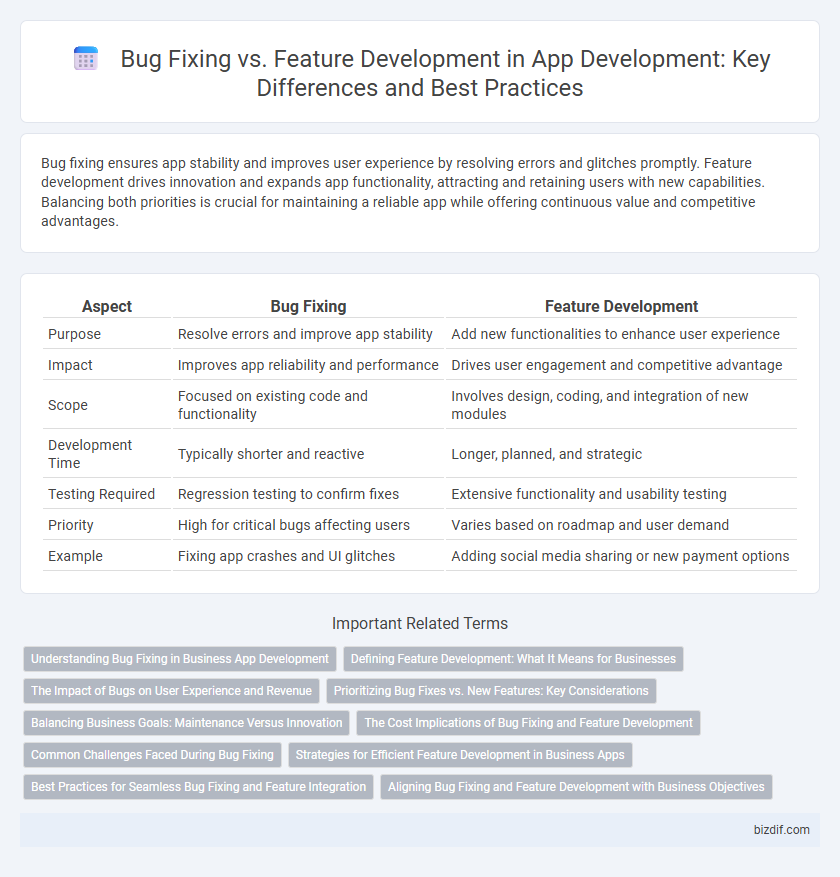Bug fixing ensures app stability and improves user experience by resolving errors and glitches promptly. Feature development drives innovation and expands app functionality, attracting and retaining users with new capabilities. Balancing both priorities is crucial for maintaining a reliable app while offering continuous value and competitive advantages.
Table of Comparison
| Aspect | Bug Fixing | Feature Development |
|---|---|---|
| Purpose | Resolve errors and improve app stability | Add new functionalities to enhance user experience |
| Impact | Improves app reliability and performance | Drives user engagement and competitive advantage |
| Scope | Focused on existing code and functionality | Involves design, coding, and integration of new modules |
| Development Time | Typically shorter and reactive | Longer, planned, and strategic |
| Testing Required | Regression testing to confirm fixes | Extensive functionality and usability testing |
| Priority | High for critical bugs affecting users | Varies based on roadmap and user demand |
| Example | Fixing app crashes and UI glitches | Adding social media sharing or new payment options |
Understanding Bug Fixing in Business App Development
Bug fixing in business app development is essential for maintaining software reliability and user satisfaction by addressing defects that disrupt functionality or security. Timely resolution of bugs ensures seamless business operations and prevents costly downtime or data breaches. Prioritizing bug fixing enhances app performance and fosters trust among stakeholders, making it a critical aspect of the development lifecycle.
Defining Feature Development: What It Means for Businesses
Feature development in app development involves creating new functionalities that enhance user experience and address market demands, directly influencing business growth and customer retention. It requires strategic planning, design, and coding to align with business objectives and competitive positioning. Investing in feature development helps companies adapt to evolving user needs and capitalize on new revenue opportunities.
The Impact of Bugs on User Experience and Revenue
Bugs in app development critically degrade user experience by causing crashes, slow performance, and unreliable functionality, leading to user frustration and increased churn rates. Negative user feedback and poor app ratings directly reduce new downloads and lower customer retention, significantly impacting revenue streams. Prioritizing timely bug fixes enhances app stability and trust, resulting in improved user satisfaction and sustained financial growth.
Prioritizing Bug Fixes vs. New Features: Key Considerations
Prioritizing bug fixes over new feature development ensures software stability, enhances user experience, and prevents potential revenue losses caused by unresolved issues. Analyzing factors such as bug severity, user impact, and release deadlines helps development teams allocate resources effectively. Balancing technical debt reduction with innovation enables sustainable growth and long-term product success.
Balancing Business Goals: Maintenance Versus Innovation
Balancing bug fixing and feature development is crucial for aligning app development with business goals, ensuring system stability while driving innovation. Prioritizing maintenance preserves user experience by addressing critical issues and preventing downtime, whereas investing in new features fuels competitive differentiation and market growth. Effective resource allocation hinges on data-driven decision-making to maximize ROI and support long-term product evolution.
The Cost Implications of Bug Fixing and Feature Development
Bug fixing in app development often incurs higher costs due to the complexity of identifying and resolving errors within existing functionality, which can lead to unplanned downtime and affect user experience. Feature development requires significant investment in design, coding, and testing, but it usually follows a structured roadmap that allows better budget forecasting. Companies that balance proactive bug fixing with strategic feature development can optimize their development budgets and reduce long-term operational expenses.
Common Challenges Faced During Bug Fixing
Bug fixing in app development often involves challenges such as identifying elusive root causes within complex codebases, which can be time-consuming and resource-intensive. Developers frequently encounter difficulties in reproducing bugs on different devices or environments, complicating the debugging process. Limited documentation and unclear error messages further hinder efficient bug resolution, impacting overall development timelines and user satisfaction.
Strategies for Efficient Feature Development in Business Apps
Efficient feature development in business apps relies on prioritizing user needs through data-driven decision-making and agile methodologies to rapidly iterate and release updates. Implementing modular architecture and continuous integration enhances code maintainability and accelerates deployment cycles, reducing time-to-market. Leveraging automated testing and real-time analytics ensures new features deliver value while minimizing disruptions and facilitating seamless user experiences.
Best Practices for Seamless Bug Fixing and Feature Integration
Effective bug fixing and feature development require maintaining a robust version control system to track changes and ensure code stability. Prioritizing clear communication between QA, developers, and product managers accelerates the identification and resolution of issues while seamlessly integrating new features. Implementing automated testing frameworks and continuous integration pipelines enhances reliability, reduces regression risks, and ensures smooth deployment cycles.
Aligning Bug Fixing and Feature Development with Business Objectives
Aligning bug fixing and feature development with business objectives ensures that software improvements directly support organizational goals such as user satisfaction, revenue growth, and market competitiveness. Prioritizing bug fixes that impact critical functionalities enhances system reliability, while feature development should target innovations that drive engagement and differentiate the product in the marketplace. Integrating a clear roadmap that balances these efforts maximizes resource efficiency and accelerates time-to-value for stakeholders.
Bug Fixing vs Feature Development Infographic

 bizdif.com
bizdif.com